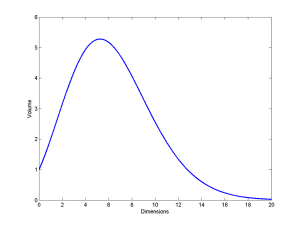Many of the most awesome formulas you meet when getting into mathematics are continued fractions like
and nested radicals like
.
What about nested/continued integrals? Here is a simple one:
.
The way to see this is to recognize that the x in the first integral is going to integrate to , the x in the second will be integrated twice
, and so on.
In general additive integrals of this kind turn into sums (assuming convergence, handwave, handwave…):
.
On the other hand, .
So if we insert we get the sum
. For
we end up with
. The differential equation has solution
. Setting
the integral is clearly zero, so
. Tying it together we get:
.
Things are trickier when the integrals are multiplicative, like . However, we can turn it into a differential equation:
which has the well known solution
. Same thing for
, giving us
. Since we are running indefinite integrals we get those pesky constants.
Plugging in gives
. If we set
we get the mildly amusing and in retrospect obvious formula
.
We can of course mess things up further, like , where the differential equation becomes
with the solution
. A surprisingly simple solution to a weird-looking integral. In a similar vein:
And if you want a real mind-bender, use the Lambert W function:
, then
.
(that is, you get an implicit but well defined expression for the (x,I(x)) values. With Lambert, the x and y axes always tend to switch place).
[And yes, convergence is handwavy in this essay. I think the best way of approaching it is to view the values of these integrals as the functions invariant under the functional consisting of the integral and its repeated function: whether nearby functions are attracted to it (or not) under repeated application of the functional depends on the case. ]
